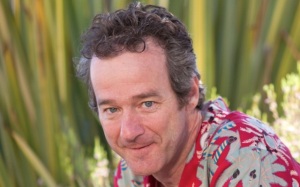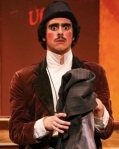by Ray Sikorski

Photo of Jeffrey Weissman (submitted photo)
SONOMA COUNTY, CA – Those who embrace comedy as their life’s work understand that the line between pleasure and pain is thin, if it even exists at all. Stan Laurel, the skinny half of the classic duo Laurel and Hardy, was as well known for busting out in tears as he was for his trademark ear-to-ear grin. The laughs come by doing a tight-rope walk along that line.
Actor Jeffrey Weissman, 50, has spent a good chunk of his life impersonating Laurel, and the sense one gets is that you don’t just learn how to do that tight-rope walk by studying it – you have to get out on the wire, and nets aren’t allowed. Pathos will quickly lead to bathos.
Growing up in Los Angeles, Weissman had an early hankering for the silver screen, but his parents – who knew first-hand about the tough lives actors lead – tried to dissuade him. Determined, Weissman took on some walk-on roles before heading to San Francisco to study at American Conservatory Theater. It wasn’t long before he was short-listed for the lead in the film War Games, along with Eric Stoltz, Dana Carvery, Sean Penn, and Matthew Broderick – who ultimately landed the role and started a career that has yet to stop. Shortly after that, Broderick, who now had some name recognition, beat Weissman out for the lead in Ladyhawke.
Weissman admits losing out on Ladyhawke was tough. He had worked for several years at Renaissance Faires, and the script resonated with him.
“There was a circle of talent that I was a part of there in the early ’80s, that were up on all these big films, but it was obviously not the right time for me to make that big breakthrough,” he says.
“Fate is a fleeting thing sometimes.”
Weissman did manage to land several small parts, including the role of Teddy Conway in Clint Eastwood’s Pale Rider, and as an airline passenger in Twilight Zone The Movie. But his biggest coup also turned out to be his biggest personal challenge, when he was asked to recreate Crispin Glover’s George McFly character in the Back to the Future sequels.
It would have been one thing to simply be Jeffrey Weissman playing George McFly. But because of complicated contract deals with Glover, Weissman was forced to become Glover, right down to prosthetic makeup. The producers didn’t want to let on that Glover wasn’t part of the sequels, so Weissman got buried in the back of shots, sometimes appeared out of focus, and he was forbidden from promoting himself as the actor – denying him the fame he desired since childhood. While he admired Glover’s performance in the first movie, the challenge of making himself into a non-entity, both on-screen and off, resulted in a nervous breakdown and a failed marriage.
Twenty years later, Weissman betrays no signs of bitterness. Since then, he’s embraced the role of struggling actor, taking both comedic and serious roles on stage and screen. His list of credits runs the gamut from Shakespeare to auto body commercials. He’s impersonated Stan Laurel, Charlie Chaplin, and Groucho Marx, and started the L.A. Theatersports improv team. He also got remarried, to the girl he fell in love with in high school.
Currently he’s living in Santa Rosa, California, working as the director of 6th Street Improv at 6th Street Playhouse, teaching at the San Francisco School of Digital Filmmaking, and working on a laundry list of acting and directing projects. His latest starring film project, Corked, a mockumentary about the wine industry, just showed at Cannes and is looking for a distributor. And he’s starting a film production company called Buzz Filmz.
“I like being alive, so I try to seize it,” he says of his busy schedule.
And, on top of all that, he proudly travels the world as George McFly, making appearances at sci-fi fan conferences and charity fundraisers.
“A lot of the big fans would come and look at me and say, ‘Well, who are you? You’re George?’ And they didn’t realize that there was a difference, because I did my job.” He says the greatest reward is making human connections with fans who see the movies as timeless classics.
“It’s not been easy overcoming the bullshit of getting depressed,” he says. “It’s not been an easy task, but I’m naturally kind of an optimistic guy, and if you wallow in the crap, it turns into more crap. I need to get back into my yoga, just like anyone else, but I’m surrounded, luckily, by a lot of family and friends, and adoring fans. So I keep my sanity that way, and keep seeing what the universe is going to provide.”
On Saturday, June 20, 2009, Jeffrey Weissman will be teaching a seminar on how to keep an acting career going at San Francisco State University. Free for SAG members. On Friday, June 26, 2009, he hosts “The Best of Sonoma County Improv,” featuring five different Sonoma County improv troupes, at the Glaser Center in downtown Santa Rosa.
Additional information about Jeffrey is available at jeffreyweissman.com.
∞
Ray Sikorski wrote and directed his first one-act play in 1988, and his second 20 years later. He is a freelance writer based in Bozeman, Montana.
Additional articles by Ray Sikorski incude:














